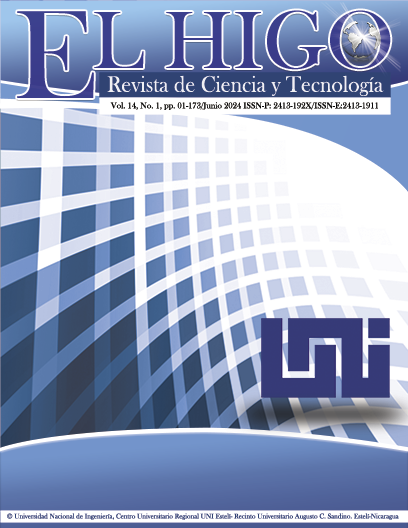Supersulphated cement from cane bagasse ash, lime and calcium sulfate for non structural applications, Nicaragua
DOI:
https://doi.org/10.5377/elhigo.v14i1.17976Keywords:
binder, gypsum, compressive strength, spectroscopy, ashAbstract
Portland cement is the most used binder worldwide, however, its production involves the emission of 1 kg of CO2 for every 1 kg of cement produced. The development of sustainable cements is necessary, with good mechanical performance, but friendly to the environment. A supersulfated cement based on sugarcane bagasse ash (SCBA) activated with calcium oxide (CaO) and calcium sulfate (CaSO4) was elaborated, obtaining a maximum value of mechanical strength (MS) of 10.75 MPa, for the mixture with a composition of 80% SCBA, 10% CaO and 10% CS. The experimental Taguchi setup was an L18 (61 x 32). 18 tests were carried out in triplicate, varying the mass ratios of the three main reagents. An ICT was used with three levels: room temperature (~35 ºC), 50 ºC and 100 ºC and a water/binder ratio with levels of 0.25, 0.30 and 0.35. A chemical characterization was carried out using Fourier transform infrared spectroscopy (FT-IR), to know the possible reaction products, being able to identify products such as lime, ettringite, silica gel and potentially CSH. Finally, the effect of the alkaline activator was determined, carrying out control tests without CaO and without CS, obtaining an MS of 7.72 MPa to the control without CS and 1.38 MPa for the control without CaO, highlighting the importance of CaO in the formation of CSH-gel.
Downloads
319
References
Cabrera-Luna, K., Maldonado-Bandala, E. E., Nieves-Mendoza, D., Castro-Borges, P., Perez-Cortes, P., y Escalante García, J. I. (2021). Supersulfated cements based on pumice with quicklime, anhydrite and hemihydrate: Characterization and environmental impact. Cement and Concrete Composites, 124. https://doi.org/10.1016/j.cemconcomp.2021.104236
Ingenio Monte Rosa. (2021). Grupo Pantaleón. Comité Nacional de Productores de Azúcar Nicaragua. https://cnpa.com.ni/monte-rosa/
Lozada, J., Investigación Aplicada: Definición, Propiedad Intelectual e Industria. CIENCIAMÉRICA, N° 3, diciembre 2014, pp (34-39) Universidad Tecnológica Indoamérica.
Mindess, S., Young, J.F. Concrete, cap.4. USA, Prentice-Hall Inc., 1981.
Nguyen Ngoc Lam 2018 IOP Conference Series: Earth and Environmental Science. 143 (2018) 012016. doi :10.1088/1755-1315/143/1/012016
Piqué, T., y Vásquez, A. (2012). Uso de la Espectroscopía Infrarroja con Transformada de Fourier (FTIR) en el estudio de la hidratación del cemento. Concreto y Cemento. Investigación y Desarrollo, 62-71.
Richardson I. G. (2008), The calcium silicate hydrates, Cement and Concrete Research vol. 38, p. 137-158.
Vásquez, T., y Blanco, M. (1981). Tabla de frecuencias y espectros de absorción infrarroja de compuestos relacionados con la química del cemento. Materiales de Construcción.
Zhou J., Yu B., Kong Y., Yang W., Cheng B., Wu J. Effect of calcium hydroxide on the microstructure and performance of super sulfated cement. Ceramics-Silikáty 66 (1), 85-94 (2022). doi: 10.13168/cs.2022.0003
Downloads
Published
How to Cite
Issue
Section
License
Copyright (c) 2024 Universidad Nacional de Ingeniería

This work is licensed under a Creative Commons Attribution-NonCommercial-NoDerivatives 4.0 International License.
All material published in the journal is shared under the Creative Commons Attribution-NonCommercial-NoDerivatives 4.0 License. Copying and redistribution of the material in any medium or format is permitted as long as explicit credit is given to the journal, the author and the work, it is distributed free of charge and without modification to the content.











